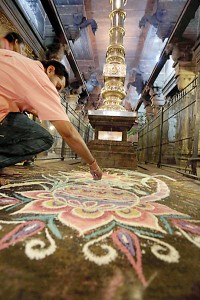A festival of thanksgiving
Hindus around the world celebrate Thai Pongal on January 15. The festival of good harvest and tribute to the sun, it derives its name from a custom practised in every household- the boiling of milk for the New Year. The milk overflowing from the pot is called Pongal and it symbolises multiplication and prosperity. Thai Pongal is the first day of the month of Thai, the tenth month of the Tamil calendar.
Although the festivities officially start on this day, the previous day is also important for Hindus. It’s the day the family gets together and cleans the house, discarding all used and burnt items such as pots and pans and even old clothing and preparing afresh for a new start. While most families still adhere to this, it’s noteworthy that customs have changed with time. While at present, old things are thrown away, in ancient times, old things were either burnt or thrown into a river – this is still practised in India.
The house is then decorated. Instead of the usual plantain trees that are planted on either side of the main entrance during festivities for New Year, Hindus plant sugar cane trees on either side of the main door. Beginning a month before Thai pongal, the women of the house would draw Kolam designs made of coconut and rice flour, usually small and in plain white, on the floor. But on Thai Pongal the Kolam too reflects the festivities and large colourful and elaborate designs mostly revolving around the sun will be seen at the entrance to any Hindu house. These special Kolam are called Rangoli Kolam. The main reason for drawing Kolam designs is to give food for the ants and other little creatures as an act of sharing the festivities with even the animals around the house.
 Preparations for the auspicious day start before dawn, when all the members of the family bathe and dress in new clothes. A fireplace for boiling the milk is prepared outside, since it’s an offering to the Sun god. When the milk boils and brims over, the head of the household puts the rice into the pot to start preparing the Pongal- a special sweet rice prepared with the first rice harvest of the previous year. To this is added jaggery, cashew, raisins, green gram and milk. This special rice, along with other sweetmeats prepared will be offered to the Sun at dawn when the first rays of sunlight touches the ground. In India, the second offering is dropped on the floor as a tribute to Earth. However, only after offering a portion of the sweetmeats to God are the family allowed to eat.
Preparations for the auspicious day start before dawn, when all the members of the family bathe and dress in new clothes. A fireplace for boiling the milk is prepared outside, since it’s an offering to the Sun god. When the milk boils and brims over, the head of the household puts the rice into the pot to start preparing the Pongal- a special sweet rice prepared with the first rice harvest of the previous year. To this is added jaggery, cashew, raisins, green gram and milk. This special rice, along with other sweetmeats prepared will be offered to the Sun at dawn when the first rays of sunlight touches the ground. In India, the second offering is dropped on the floor as a tribute to Earth. However, only after offering a portion of the sweetmeats to God are the family allowed to eat.
The next important event is going to the Kovil. Several important poojas take place on this special day such as the Komathanam Pooja and the Pal Abhishekam. Komathanam Pooja is when a cow is brought into the Kovil or the house and is made to go around the house. This circumambulation by the cow around the house is believed to bring luck, wealth and prosperity to the inhabitants. The Pal Abhishekam happens in a Kovil when devotees bathe the main statue of the deity of the Kovil with milk.
the Komathanam Pooja and the Pal Abhishekam. Komathanam Pooja is when a cow is brought into the Kovil or the house and is made to go around the house. This circumambulation by the cow around the house is believed to bring luck, wealth and prosperity to the inhabitants. The Pal Abhishekam happens in a Kovil when devotees bathe the main statue of the deity of the Kovil with milk.
After returning home, Hindus visit their friends and relations to exchange sweetmeats and wishes as a gesture of strengthening their bonds and relationships in the coming New Year.
The next day, January 16 is called Mattu-pongal, where families pay tribute to the farm animals, chiefly cows and buffaloes which have been helping them in their farming activities. The animals are bathed and decorated with their horns painted in brilliant colours. In some farming families, Pongal is cooked again and given to the animals as pooja. Offerings are also offered to the plough and other farming equipment.
Thai Pongal deserves a special place in the Sri Lankan calendar, especially as we pride ourselves on our agricultural society. It is a festival of thanksgiving and showing gratitude to nature for all it has given to us in the past year, specially our staple food, rice. It is a festival that celebrates our eastern qualities of gratitude and appreciation.


